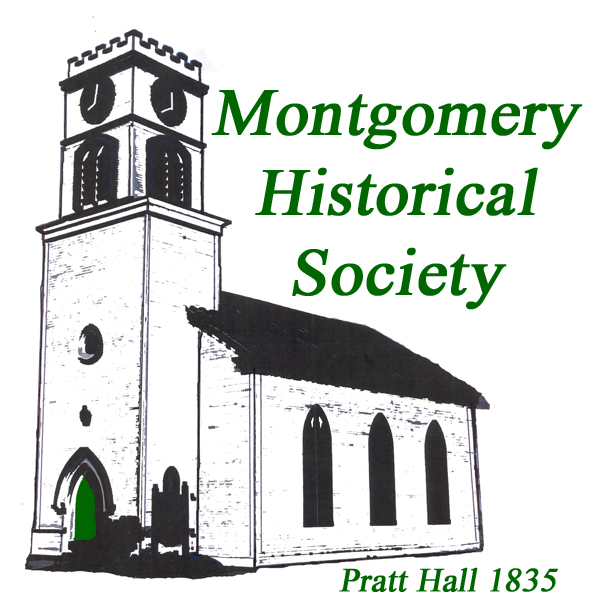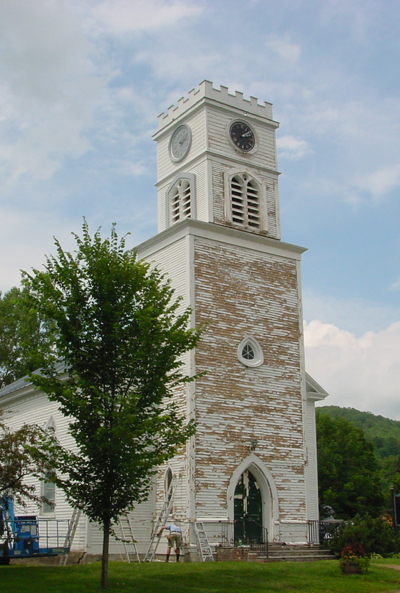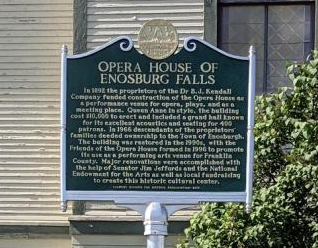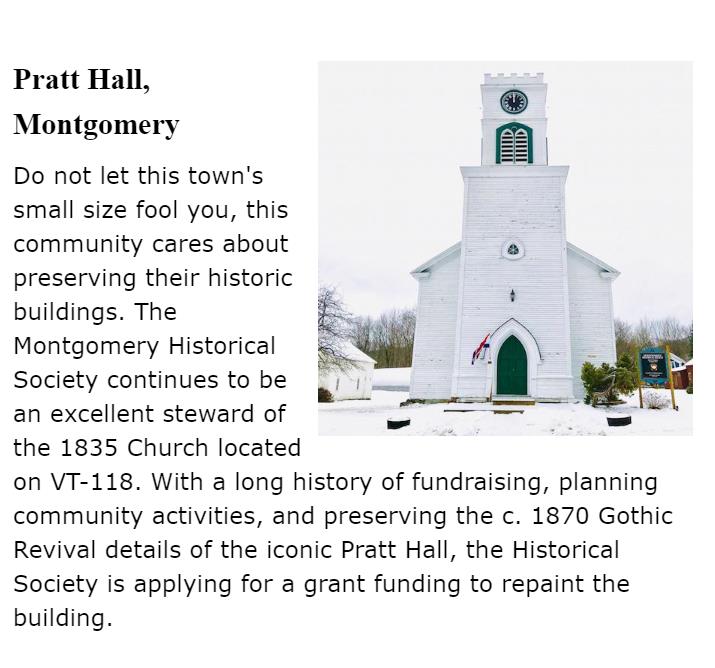
2nd Quarter
Number 62
The Quarterly Newsletter of the
Montgomery Historical Society
P.O. Box 47
Montgomery, VT 05471
e-mail pratthall@gmail.com
www.montgomeryhistoricalsociety.org
Click here for a printer friendly pdf version

April 2020
2nd Quarter Number 62 |
Artifacts
& Fiction The Quarterly Newsletter of the Montgomery Historical Society P.O. Box 47 Montgomery, VT 05471 e-mail pratthall@gmail.com www.montgomeryhistoricalsociety.org Click here for a printer friendly pdf version |
 Tower
Scraped, 2006
|
| Scott
Perry,Chair/Editor Bill McGroarty,Vice Chair Marijke Dollois,Secretary Pat Farmer,Treasurer The MHS Board meets the third Thursday of the month at 5:00 p.m. Pratt Hall in the Summer, Public Safety Building Conference Room in the Winter. History Quiz:
1. How many Vermonters died in the 1918 Spanish Flu
Epidemic?
a.
1,000
b. 2,000 c. 3,000 d. 4,000 2. Which was not a common treatment for the flu? a. Brandy b. Chicken Soup c. Mustard Plasters d. Antibiotics 3. True or False? The 1918 Spanish Flu probably originated in Kansas. |
An
Account
of the 1918 Spanish Flu in Montgomery,
Excerpted from "Then Again: In an age before antibiotics, a killer epidemic struck Vermont" By Mark Bushnell, VT Digger March 8, 2020, used by permission "In 1918, Gifford Owen was 10 years old and living in Montgomery Center when he got the flu. Owen remembered almost nothing from the first few days he was sick. “I was out, just completely out,” he told an interviewer in 1998. Owen’s sister Viola was the only one of the eight family members who didn’t become ill even though she spent days caring for others. While Owen lay sick, the epidemic tore through town. People did what they could to help one another. Chicken soup was the cure-all of the day. “Whether you had whooping cough or a sore foot, it didn’t matter,” Owens said, “that’s what you got.” So Emma Shover, a deaconess at the Baptist church, made a kettle of chicken soup and used a wheelbarrow to deliver it to the houses of the sick. Elsewhere in town, Colonel Slater, vice president of Nelson & Hall Tub Mill, took an axe to the sugar and butter tubs and Victrola cabinets his company made and delivered firewood to shut-ins. In the following weeks, Owen’s grandfather Eli Manosh and his great-uncle Edmond Manosh would put wood to another use. They would build 200 coffins for people who died in the area, Owen said. Decades later, Gifford Owen recalled the day his parents allowed him to leave his sickbed and walk several blocks on an errand. Recent rains had turned the roads muddy, but the day’s cold weather had formed a crust over them. “Horses’ hooves left hundreds and hundreds of mirror-like holes in the road,” he said. “Breaking those little ponds was such a delight. “Even the air was different. I remember breathing real hard to inhale something I hadn’t felt in weeks. … And the wonderment of being able to walk, it was as if you had come back from the grave.” Mark Bushnell is a Vermont journalist and historian. He is the author of "Hidden History of Vermont" and "It Happened in Vermont". Full article at vtdigger.org We hope this newsletter is a pleasant diversion from all the mayhem and stress visited on us all by the COVID 19 virus. Take care everyone, Scott |
|
"AT THIS PLACE IN HISTORY"
TV channels 22 and 44, in partnership with the
Vermont Historical Society, air weekly episodes on Vermont history
called "At This Place in History". We spent about
three
hours with host Amanda Thibault, cameraman Steve Longchamp,
and
VHS Director Steve Perkins on a bright sunny day in February filming
two episodes.
Episodes on Pratt Hall, and butter tubs and packing crates were aired during morning and evening newscasts later that month. They, and other episodes, are available at the links above and at mychamplainvalley.com  Screen shot of Butter Tubs and Packing Cases Episode 2020 SCHOLARSHIP APPLICATIONS DUE BY MAY 1ST Applications for our
annual Lalia
Pratt Hays / Amy Booth Meyers Scholarship and the Joe and Irene
Scott Scholarship are due May 1st.
All graduating Montgomery seniors going on to future
education / training are eligible. This includes technical
training, e.g. CDL, as well as college.
ROADSIDE HISTORIC MARKERS
We are working
with the Town and State to
have Roadside Historic Markers placed at our covered bridges and at
Pratt Hall. The familiar green signs contain a short
description of each site and it's significance.
This is a time consuming process so installation timing, if approved by
the State,
is uncertain. The State pays for the signs.
 All of Montgomery's bridges are already listed on the National Register of Historic Places, as is Pratt Hall, the Black Lantern, and the Montgomery Center for the Arts building. Copies of each's nomination are on our web site. 2020 FARMERS
MARKETS
Covid-19 permitting, year four of our Farmer's Market will begin June 20 and run through September 26th, every Saturday from 9:00 to 1:00. Plan on even more vendors, music, and goodies. If you are interested in vending please contact Sue Wilson, 326-4189 or email her at sue_wilson@fairpoint.net. 2019 TOWN REPORT INPUT For this year's report we provided a two page article, "A Short, Modern History of Pratt Hall". It highlighted some of the major restoration work we've done since 2008, thanked the community and welcomed future support. THIS QUARTER IN
MONTGOMERY HISTORY
April: 1865. Morris Braman dies, last Montgomery casualty of Civil War. Died one month after being paroled from a POW camp.
May: 1819. Episcopal congregation
organizes, holds election. HISTORY QUIZ
ANSWERS
1. b. About 2,100 Vermonters died in the 1918 influenza Spanish Flu epidemic 2. d. Antibiotics had not been discovered and while ineffective for viruses, most people died from bacterial complications resulting from the virus. 3. True. "Researchers now believe the disease started at Fort Riley, Kansas, with an outbreak among soldiers in March 1918. Those soldiers carried the disease to Europe when they shipped out to fight in World War I. The virus spread quickly among the troops, who were clustered together in unsanitary conditions. Germany, England and France censored reports of the disease, for fear of hurting their war effort. Spain, as a neutral country, did not. So Spanish papers were the first to report the outbreak, and the disease became linked with Spain." Source: "Then Again: In an age before antibiotics, a killer epidemic struck Vermont" By Mark Bushnell, VT Digger March 8, 2020 |
MARCH MEMBERSHIP DRIVE POSTPONED You will be receiving our annual
membership reminder letter after the Covid 19 virus events settle down,
probably in late April or Early May. You
can renew / join online anytime.
Revenue from membership dues is the life blood of our Society. Dues donations fund our operating costs (e.g. heat, water, power, insurance, grounds), and our programs (e.g. preservation, speakers, concerts, holiday events). Bill Branthoover was fond of telling people "we have never asked for money from the Town's tax roles except for a one time payment to help fund the publishing of the first edition of the Town History in 1976". Everything else (including two more editions) has been funded by donations, and grants. Your membership is also an important factor which grant administrators consider when deciding whether to award us a grant. It is seen as a metric on the health of our organization, community support, and our ability to effectively spend their money. THANK
YOU!
2020 MEMORIAL DAY OBSERVANCE Covid-19 developments permitting, this year's commemoration will be on the Town Common (in the Village) at Noon on May 24th. It will include military honors by American Legion post 42, roll call, and brief remarks. We will update you via email, facebook and our websites of any changes. 2020
ANNUAL MEETING
Our by-laws require an Annual Meeting in June but we are thinking this may need to slip due to the social isolation requirements we are under. We hope to repeat our general plan to start with a short business meeting at Pratt Hall open to all members and their guests, and conclude with a sit down dinner at the Black Lantern for the first 50 to make paid reservations. We will update you via mail, email, facebook, and our websites once we have a better understanding of when this makes sense. Thanks for your underdtanding. PRESERVATION TRUST OF VERMONT (PTV) VISIT AND 1772 FOUNDATION GRANT  1772 GRANT
We were one of 26 organizations, out of
46 statewide submitting
Letters of Interest, who were invited to submit an application.
We think about half of those will receive grants, and should
hear how we fared soon. Keep
your fingers crossed.
One question the 1772 grant application includes is "Why does this project matter?": Our response: When this building was teetering on demolition in 1973 and the Episcopal Diocese of Vermont was considering its options, it was clear we almost lost this jewel due to the cumulative lack of normal, routine, periodic maintenance, and because there were no longer any clear local stake holders with the power to bring resources to bear. The community response was emotional which speaks to the building’s importance to our sense of community, place, and heritage. Keeping this building in great shape and using it matters because it is a critical ingredient of who we were and who we are. It connects us to our past and to each other, and as sociologists warn this social capital and connectedness is a critical ingredient for strong communities and social networks. In a more physical sense, until now, grant dollars were not available for this type of maintenance. Water is the enemy of buildings and without this painting the building would likely suffer more serious damage that would be even more expensive to remedy in the future, possibly even compromising the structural restorations we’ve already done. Deferring maintenance is unavoidable sometimes. This grant will help us complete an overdue project and extend the legacy of those early settlers who arrived nearly 227 years ago. |
Thanks for your support!
Not a member... why not join us?
|